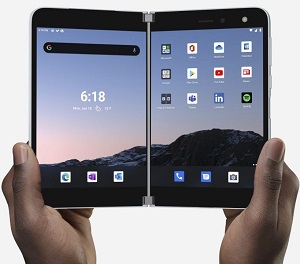News
Surface Duo Debut Presents Dual-Screen Dev Challenges
Microsoft officially launched its new dual-screen Android device, Surface Duo, presenting new challenges -- and opportunities -- for developers to leverage the new form factor.
The Surface Duo connects two PixelSense Fusion Displays to create one 8.1-inch screen with a hinge in the middle.
 [Click on image for larger view.] Microsoft Surface Duo (source: Microsoft).
[Click on image for larger view.] Microsoft Surface Duo (source: Microsoft).
Microsoft has published much guidance on dealing with app development for dual-screen devices, along with an SDK that contains helper functions and layout controls for multiple developer ecosystems, along with documentation and training materials:
Also, even though Microsoft says, "your existing Android apps will work just as expected and out of the box," the company earlier published "Bring your app to Surface Duo" guidance, with three main steps:
- Test an app using Duo Emulator to ensure it works.
- Make incremental changes using Android Native APIs and Libraries so the app works better on dual-screen devices even when running side-by-side in single-screen mode.
- Use Microsoft's Dual-Screen Preview SDK and embrace new features such as postures and app patterns.
The Surface Duo also provides opportunities for developers to enhance existing apps and create new ones, Microsoft said, including leveraging a variety of dual-screen app patterns:
 [Click on image for larger view.] Dual-Screen App Patterns (source: Microsoft).
[Click on image for larger view.] Dual-Screen App Patterns (source: Microsoft).
The company said Surface Duo development can be done using the following common languages and IDEs:
- Kotlin & Java using Android Studio on Windows, macOS, or Linux
- Xamarin using C# with Visual Studio on Windows or macOS
- React Native using JavaScript or TypeScript
- Unity for game development
- Flutter
- Web sites and PWAs
More information can be found in the August 12 Surface Duo announcement post.
About the Author
David Ramel is an editor and writer at Converge 360.